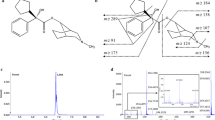Abstract
In-vitro incubation of human cerebrospinal fluid (CSF) obtained from patients ranging from 22–78 years with 10 μM of dynorphin A1–13 (Dyn A1–13) resulted in several cleavage products. Dyn A1–12 and A2–13 were identified as the major CSF metabolites by matrix-assisted laser desorption mass spectrometry (LD-MS). Further metabolites were Dyn A1–6, A2–12 and A4–12. LD-MS further suggested the formation of Dyn A1–8, A1–7, A1–10, A7–10, A3–12, A7–12, A3–13, A7–13 and A8–13. The metabolic half-life of Dyn A1–13 at 37°C was approximately 2.5 h (range 1.75–8.5 h), compared to less than one minute in plasma. The half-life of Dyn A1–13 decreased markedly with age or age-associated processes (n=20, r2=0.498). Noncompartmental kinetic analysis in the absence or presence of enzyme inhibitors (leucinethiol 10 μM, captopril 100 μM and GEMSA 20 μM) suggested that Dyn A1–13 is mainly metabolized by carboxypeptidase to A1–12 (51%) and by aminopeptidases to A2–13 (35%). The generation of A1–6 (13%) was only detected under enzyme inhibition. The extent of conversion into the main metabolites did not follow an age-associated trend, thus over-all enzyme levels but no specific enzymatic systems are elevated with age.
Similar content being viewed by others
References
Goldstein, A., Tachibana, S., Lowney, L. I., Hunkapillar, M., and Hood, L. 1979. Dynorphin-(1–13), an extraordinarily potent opiod peptide. Proc. Natl. Acad. Sci. USA, 76:6666–6670.
Herman, B. H., and Goldstein, A. 1985. Antinociception and paralysis induced by intrathecal dynorphin A. J. Pharm. Exp. Ther., 232:27–32.
Wen, H. L., and Ho, W. K. K. 1982. Suppression of withdrawal symptoms by dynorphin in heroin addicts. Eur. J. Pharmacol., 82: 183–186.
Mueller, S., and Hochhaus, G. 1995. Metabolism of dynorphin A1–13 in human blood and plasma. Pharm. Res., 12:1165–1170.
Leslie, F. M., and Goldstein, A. 1982. Degradation of dynorphin A1–13 by membrane-bound rat brain enzymes. Neuropeptides, 2: 185–196.
Terenius, L., and Nyberg, F. 1988. Neuropeptide-processing, converting, and-inactivating enzymes in human cerebrospinal fluid. Int. Rev. Neurobiology, 30:101–121.
Nyberg, F., Nordstrom, K., and Terenius, L. 1985. Endopeptidase in human cerebrospinal fluid which cleaves proenkephalin B opioid peptides at consecutive basic amino acids. Biochem. Biophys. Res. Com., 131:1069–1074.
Persson, S., Post, C., Alari, L., Nyberg, F., and Terenius, L. 1989. Increased neuropeptide-converting enzyme activities in cerebrospinal fluid of opiate-tolerant rats. Neurosc. Lett., 107:318–322.
Hazato, T., Shimamura, M., Katayama, T., Kasama, A., Nishioka, S., and Kaya, K. 1983. Enkephalin degrading enzymes in cerebrospinal fluid. Life Sciences, 33:443–448.
S. Bolton, 1990. Pharmaceutical Statistics, Dekker, New York and Basel, p. 250.
Seyfried, C. A., and Tobler, P. 1990. HPLC systems for the separation of dynorphin A (1–17) fragments and its application in enzymolysis studies with rat nerve terminal membranes. J. Chrom., 529:43–54.
Shibanoki, S., Weinberger, S. B., Ishikawa, K., and Martinez, J. L. 1991. Further characterization of the in vitro hydrolysis of [Leu]- and [Met]enkephalin in rat plasma: HPLC-ECD measurement of substrate and metabolite concentrations. Regul-Pept., 32: 267–278.
Gideon, P., Thomsen, C., Ståhlberg, F., and Henriksen, O. 1994. Cerebrospinal fluid production and dynamics in normal aging: a MRI phase-mapping study. Acta Neurol. Scand. 89:362–366.
A. J. Kenny and N. M. Hooper 1991. Peptidases involved in the metabolism of bioactive peptides. Pages 47–79. In J. H. Hendriksen (ed.), Degradation of bioactive substances: Physiology and pathophysiology, CRC Press, Inc., Boca Raton.
Lantz, I., Nyberg, F., and Terenius, L. 1991. Molecular heterogeneity of angiotensin converting enzyme in human cerebrospinal fluid. Biochem. Int., 23:941–948.
Nyberg, F., Lyrenas, S., and Terenius, L. 1986. Assay and biochemical characterization of a dynorphin converting enzyme in human cerebrospinal fluid. NIDA Res. Monogr., 75:251–254.
Yukhananov, R. Y., Zhai, Q. Z., Persson, S., Post, C., and Nyberg, F. 1993. Chronic administration of morphine decreases level of dynorphin A in the rat nucleus accumbens. Neuropharmacology, 32:703–709.
Takemori, A. E., Loh, H. H., and Lee, N. N. 1993. Suppression by dynorphin A and [des-Tyr1] dynorphin A peptides of the expression of opiate withdrawal and tolerance in morphine-dependent mice. J. Pharm. Exp. Ther., 266:121–124.
Shukla, V. K., and Lemaire, S. 1994. Non-opioid effects of dynorphins: possible role of the NMDA-receptor., TIPS, 15:420–424.
Persson, S., Le Greves, M., Thörnwall, M., Eriksson, U., Silberring, J., and Nyberg, F. 1995. Neuropeptide converting, and processing enzymes in the spinal cord and cerebrospinal fluid. Pages 111–130in Nyberg, F., Sharma, H. S., Wiesenfeld-Hallin, Z. (eds), Progress in brain research, Vol 104, Elsevier Science, Amsterdam.
Csuhai, E., Little, S. S., and Hersh, L. B. 1995. Inactiviation of neuropeptides. Pages 131–142,in Byberg, F., Sharma, H. S., Wiesenfeld-Hallin, Z. (eds), Progress in brain research, Vol 104, Elsevier Science, Amsterdam.
Benter, I. F., Hirsh, E. M., Tuchman, A. J., Ward, P. E. 1990. Nterminal degradation of low molecular weight opioid peptides in human cerebrospinal fluid. Biochem. Pharmacol. 40:465–472.
Author information
Authors and Affiliations
Rights and permissions
About this article
Cite this article
Müller, S., Grundy, B.L. & Hochhaus, G. Metabolism of dynorphin A1–13 in human CSF. Neurochem Res 21, 1213–1219 (1996). https://doi.org/10.1007/BF02532398
Accepted:
Issue Date:
DOI: https://doi.org/10.1007/BF02532398




